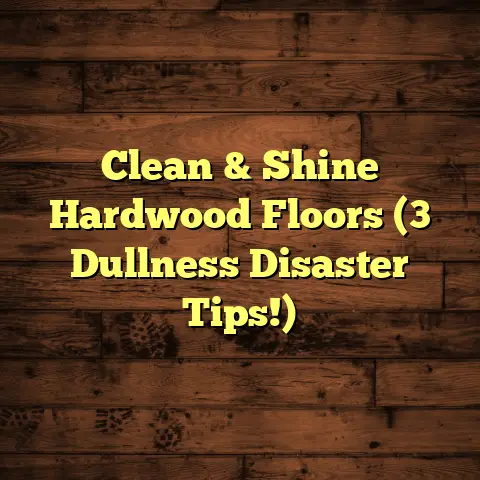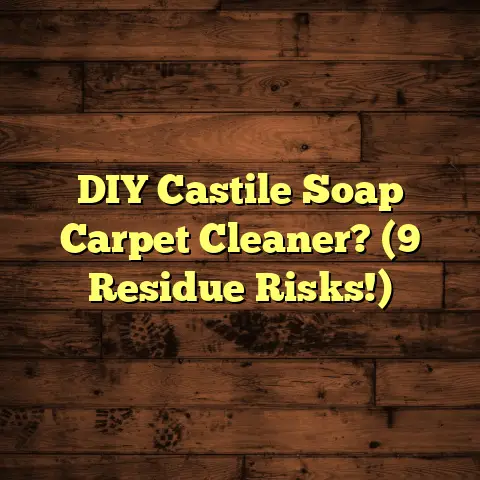Level Floors For LVP? (4 Hour Prep Secret!)
Want to achieve perfectly level floors for your Luxury Vinyl Plank (LVP) installation?
Forget spending days agonizing over prep work.
I’ve got a game-changing technique that can drastically cut down your prep time—we’re talking as little as 4 hours!
This “4-Hour Prep Secret” will not only save you time and sweat but also ensure a flawless, long-lasting LVP finish.
Even if you’re a DIY newbie, you can nail this!
In this article, I’ll walk you through everything you need to know to master floor leveling and elevate the look and lifespan of your LVP flooring.
Trust me, this is a game-changer.
Let’s dive in!
Section 1: Understanding LVP Flooring
So, what exactly is Luxury Vinyl Plank (LVP) flooring?
Think of it as the cool cousin of traditional vinyl flooring.
It’s made from multiple layers of synthetic materials, typically including a PVC core, a printed decorative layer, and a protective wear layer.
This construction makes it incredibly durable, waterproof, and resistant to scratches and stains.
LVP comes in planks that mimic the look of real hardwood, stone, or tile, but at a fraction of the cost and with much less maintenance.
Why is LVP so popular these days?
Well, for starters, it’s incredibly versatile.
You can install it in just about any room, from kitchens and bathrooms to basements and living rooms.
It’s also super easy to clean and maintain.
A quick sweep or mop is usually all it takes to keep it looking its best.
Plus, it’s comfortable underfoot and quieter than many other hard flooring options.
But here’s the thing: the success of any LVP installation hinges on one crucial factor: the condition of the subfloor.
If your subfloor is uneven, you’re setting yourself up for trouble.
I’ve seen it happen time and time again.
Section 2: The Importance of Level Floors
Why is a level subfloor so critical for LVP?
Imagine trying to build a house on a shaky foundation—it’s just not going to work.
The same principle applies to LVP flooring.
An uneven subfloor can lead to a whole host of problems, including:
Increased Wear and Tear: When LVP planks aren’t fully supported, they’re more likely to flex and bend underfoot.
This constant movement can cause the planks to wear out prematurely, especially at the seams.Gaps and Buckling: Unevenness can create gaps between planks, which not only looks bad but also allows moisture and debris to seep in.
Over time, this can lead to buckling and warping.Difficulty in Installation: Trust me, trying to install LVP on an uneven floor is a nightmare.
The planks won’t lay flat, making it difficult to achieve a clean, professional-looking finish.You’ll be fighting with the material every step of the way, and the end result will likely be far from perfect.
Industry standards and manufacturer recommendations are crystal clear on this point: a level subfloor is essential for a successful LVP installation.
Most manufacturers specify a maximum allowable variation of no more than 3/16 inch over a 10-foot span.
Think about it like this: if you want your LVP flooring to look great, last long, and perform as it should, you have to start with a level foundation.
There’s just no getting around it.
Section 3: Common Problems with Uneven Floors
So, what causes uneven floors in the first place? There are several culprits:
Age and Settling: Over time, buildings naturally settle, which can cause floors to shift and become uneven.
This is especially common in older homes.Water Damage or Moisture Issues: Water is the enemy of floors.
Leaks, floods, or even high humidity can cause subflooring to warp, swell, and become uneven.Improper Installation of Previous Flooring: Sometimes, uneven floors are simply the result of poor workmanship.
If the original subfloor wasn’t properly prepared, any subsequent flooring installed on top of it will likely suffer the consequences.
I remember one job where the homeowner had installed LVP directly over an old, uneven tile floor.
Within a few months, the LVP started to buckle and the seams began to separate.
When I pulled up the LVP, I found that the tile floor underneath was riddled with cracks and dips.
The homeowner had tried to save time and money by skipping the leveling process, but it ended up costing them much more in the long run.
Here’s another example:
I once worked on a house where a leaky pipe had caused significant water damage to the subfloor.
The floor was so uneven that you could actually feel it sloping as you walked across the room.
The homeowner was understandably frustrated, but I assured them that we could fix the problem with proper leveling.
We ended up using a self-leveling compound to create a smooth, even surface for the new LVP flooring.
The end result was a beautiful, durable floor that the homeowner loved.
These are just a couple of examples, but they illustrate the importance of addressing uneven floors before installing LVP.
Ignoring the problem will only lead to headaches down the road.
Section 4: The 4-Hour Prep Secret
Alright, let’s get to the good stuff!
I’m about to reveal my “4-Hour Prep Secret” for achieving perfectly level floors for LVP.
This method is designed to be quick, efficient, and effective, even for DIYers.
But, please note: this timeframe is a general estimate.
The actual time it takes may vary depending on the size of the area, the severity of the unevenness, and the specific products you use.
Here’s the breakdown:
1. Assessment: How to Evaluate the Current State of the Subfloor
Before you start slathering on self-leveling compound, you need to get a clear picture of what you’re working with.
This means thoroughly assessing the condition of your subfloor.
Tools Needed:
- Level (4-foot or 6-foot): A long level is essential for identifying high and low spots.
- Measuring Tape: You’ll need this to measure the dimensions of the room and to mark any areas that need special attention.
- Straight Edge: A long, straight piece of wood or metal can also be used to identify unevenness.
- Moisture Meter: This is optional, but highly recommended.
Moisture can wreak havoc on your subfloor, so it’s important to make sure it’s dry before you start leveling. - Pencil or Marker: For marking areas that need repair or leveling.
Signs of Unevenness and How to Identify Them:
- Visual Inspection: Start by simply looking at the floor.
Do you see any obvious dips, humps, or cracks?
Are there any areas where the floor appears to be sloping? - Using a Level: Place the level on the floor in various locations, both lengthwise and widthwise.
If the bubble isn’t centered, it indicates that the floor is uneven.
Use a pencil to mark any areas that are out of level. - Using a Straight Edge: Place the straight edge on the floor and look for gaps between the straight edge and the floor.
This will help you identify subtle variations in the floor’s surface. - Rolling a Ball: This is a simple but effective way to identify unevenness.
Roll a ball across the floor and see if it veers off in any particular direction.
This can help you pinpoint areas that are sloping or have significant dips.
Pro Tip: Don’t just focus on the big, obvious problems.
Pay attention to the small details, too.
Even minor imperfections can cause problems with your LVP installation.
2. Materials Needed:
Okay, now that you know what you’re up against, it’s time to gather your supplies.
Here’s a list of the materials you’ll need for the “4-Hour Prep Secret”:
- Self-Leveling Compound: This is the star of the show.
Self-leveling compound is a cement-based mixture that you pour onto the floor.
It flows easily and self-levels, creating a smooth, even surface.
I recommend using a high-quality self-leveling compound that is specifically designed for use with LVP flooring. - Primer: Primer helps the self-leveling compound bond to the subfloor.
It also helps to prevent the compound from drying out too quickly.
Make sure to use a primer that is recommended by the manufacturer of your self-leveling compound. - Mixing Bucket: You’ll need a large bucket to mix the self-leveling compound.
I recommend using a bucket that is at least 5 gallons in size. - Drill with Mixing Paddle: A drill with a mixing paddle will make it much easier to mix the self-leveling compound.
You can buy mixing paddles at most hardware stores. - Trowel: A trowel is used to spread the self-leveling compound evenly across the floor.
I recommend using a notched trowel, as this will help to ensure that the compound is applied at the correct thickness. - Spiked Roller (Optional): A spiked roller can be used to remove air bubbles from the self-leveling compound.
This is especially important if you’re applying a thick layer of compound. - Gloves: Self-leveling compound can be harsh on your skin, so it’s important to wear gloves.
- Dust Mask: Mixing self-leveling compound can create a lot of dust, so it’s important to wear a dust mask.
- Safety Glasses: Protect your eyes from splashes and dust.
- Shop Vacuum: For cleaning the subfloor before applying the primer.
- Painter’s Tape: To protect walls and trim.
A quick word on self-leveling compound:
There are many different brands and types of self-leveling compound on the market.
Do your research and choose a product that is right for your specific needs.
Consider factors such as the thickness of the compound, the drying time, and the compatibility with LVP flooring.
I’ve had good experiences with brands like Ardex, Mapei, and Henry, but ultimately, the best product for you will depend on your specific project.
3. Preparation: Step-by-Step Instructions on How to Prepare the Subfloor
Before you can start leveling, you need to properly prepare the subfloor.
This involves cleaning the area, repairing any minor damages, and applying primer.
Step 1: Cleaning and Clearing the Area
- Remove all existing flooring, baseboards, and any other obstructions from the room.
- Thoroughly sweep or vacuum the subfloor to remove any dust, dirt, or debris.
- Use a scraper to remove any stubborn adhesive or residue.
- If there are any oil or grease stains, clean them with a degreaser.
Step 2: Repairing Minor Damages Before Leveling
- Fill any small cracks or holes with a concrete patching compound.
- Use a trowel to smooth the patching compound and let it dry completely.
- If there are any loose or damaged areas of the subfloor, repair them with a wood or concrete repair product.
- Make sure the repairs are flush with the surrounding surface.
Step 3: Priming the Subfloor
- Apply a thin, even coat of primer to the subfloor using a paint roller or brush.
- Make sure to cover the entire surface, including the edges and corners.
- Let the primer dry completely according to the manufacturer’s instructions.
This is crucial for proper bonding of the self-leveling compound.
Why is priming so important?
Think of primer as the glue that holds everything together.
It creates a strong bond between the subfloor and the self-leveling compound, preventing the compound from cracking or peeling over time.
It also helps to prevent the subfloor from absorbing moisture from the compound, which can weaken the bond and lead to problems down the road.
4. Application: Detailed Instructions on Applying a Self-Leveling Compound
Alright, now for the main event: applying the self-leveling compound!
This is where the magic happens.
Step 1: Mixing the Compound
- Carefully read the manufacturer’s instructions for mixing the self-leveling compound.
This is crucial, as the mixing ratio can vary depending on the product. - Pour the recommended amount of water into the mixing bucket.
- Gradually add the self-leveling compound to the water while mixing with a drill and mixing paddle.
- Mix for several minutes until the compound is smooth and lump-free.
The consistency should be similar to pancake batter.
Step 2: Pouring and Spreading Techniques
- Pour the self-leveling compound onto the subfloor in a continuous stream.
Start in one corner of the room and work your way across. - Use a trowel to spread the compound evenly across the floor.
Make sure to fill in any low spots or dips. - If you’re using a notched trowel, hold it at a 45-degree angle to the floor.
This will help to ensure that the compound is applied at the correct thickness. - Work quickly and efficiently, as the self-leveling compound will start to harden within a few minutes.
Step 3: Removing Air Bubbles (Optional)
- If you’re using a spiked roller, roll it across the surface of the self-leveling compound to remove any air bubbles.
- This is especially important if you’re applying a thick layer of compound.
Tips for Ensuring an Even Surface:
- Work in small sections to prevent the compound from drying out before you can spread it evenly.
- Use a level to check your progress as you go.
If you see any areas that are too high or too low, adjust accordingly. - Don’t overwork the compound.
Once it’s spread evenly, leave it alone.
Overworking can cause the compound to separate and weaken.
5. Drying and Curing:
Discuss the importance of allowing the compound to dry and cure properly.
- Timeframes for drying based on different products.
- How to check if the surface is level post-curing.
Step 1: Drying Time
- Refer to the manufacturer’s instructions to determine the appropriate drying time for the self-leveling compound.
- Drying times can vary depending on the product, the thickness of the application, and the ambient temperature and humidity.
- Generally, self-leveling compounds require at least 24-48 hours to dry completely.
Step 2: Curing Time
- Curing is the process by which the self-leveling compound hardens and reaches its full strength.
- Curing times can also vary depending on the product and environmental conditions.
- Some self-leveling compounds may require several days or even weeks to fully cure.
Step 3: Checking for Levelness
- Once the self-leveling compound has dried and cured, use a level to check the surface for levelness.
- Place the level on the floor in various locations and check to see if the bubble is centered.
- If you find any areas that are still uneven, you may need to apply another thin layer of self-leveling compound.
Pro Tip: Be patient!
Don’t rush the drying and curing process.
If you install your LVP flooring before the self-leveling compound is fully dry and cured, you could end up with problems down the road.
Section 5: Benefits of the 4-Hour Prep Secret
Okay, so why should you bother with this “4-Hour Prep Secret”?
What’s in it for you?
Well, for starters, it can save you a ton of time and labor costs.
Traditional floor leveling methods can be incredibly time-consuming and labor-intensive.
They often involve multiple steps, such as grinding, patching, and sanding.
This can add days or even weeks to your project, and it can also be quite expensive if you’re hiring a professional contractor.
The “4-Hour Prep Secret,” on the other hand, streamlines the process and allows you to achieve a level floor in a fraction of the time.
This can save you hundreds or even thousands of dollars in labor costs.
But the benefits don’t stop there.
A properly leveled floor also has long-term benefits for your LVP installation.
As I mentioned earlier, an uneven subfloor can lead to increased wear and tear, gaps, buckling, and other problems.
By leveling your floor before installing LVP, you can prevent these problems and extend the life of your flooring.
You’ll also enjoy a more comfortable and aesthetically pleasing floor.
LVP flooring looks and feels much better when it’s installed on a level surface.
Here’s what one of my clients, Sarah, had to say about the “4-Hour Prep Secret”:
“I was dreading the thought of leveling my floors before installing LVP.
I had heard that it was a long, difficult process.
I was able to level my floors in just a few hours, and the LVP installation went perfectly.
My new floors look amazing, and I couldn’t be happier!”
Section 6: Troubleshooting Common Issues
Even with the best preparation, things can sometimes go wrong.
Here are some common issues you might encounter during the leveling process, and how to address them:
- Air Bubbles in the Compound: If you notice air bubbles in the self-leveling compound, use a spiked roller to remove them.
If you don’t have a spiked roller, you can also use a trowel to gently smooth out the bubbles. - Incomplete Drying: If the self-leveling compound doesn’t dry completely, it could be due to high humidity or low temperature.
Try to increase the ventilation in the room and/or use a dehumidifier to speed up the drying process. - Poor Application Techniques: If you’re not experienced with self-leveling compound, it can be tricky to apply it evenly.
Practice on a small area first to get a feel for the material.
If you make a mistake, don’t panic.
You can usually correct it by adding more compound or smoothing it out with a trowel.
What if you discover unevenness after the compound has dried?
Don’t worry, it’s not the end of the world. You have a few options:
- Apply Another Layer of Self-Leveling Compound: This is the easiest solution if the unevenness is minor.
Simply apply another thin layer of compound to the affected area and smooth it out with a trowel. - Grind Down High Spots: If there are any high spots, you can use a concrete grinder to smooth them down.
Be careful not to grind too much, as this could damage the subfloor. - Use Shims: If the unevenness is significant, you may need to use shims to level the floor.
Shims are thin pieces of wood or plastic that you can place under the LVP planks to create a level surface.
The key is to be patient and persistent. Don’t be afraid to experiment and try different solutions until you achieve the desired result.
Section 7: Conclusion
Alright, we’ve covered a lot of ground in this article.
Let’s recap the key points:
- Luxury Vinyl Plank (LVP) flooring is a popular and versatile option for homeowners.
- A level subfloor is essential for a successful LVP installation.
- Uneven floors can lead to increased wear and tear, gaps, buckling, and other problems.
- The “4-Hour Prep Secret” is a streamlined method for preparing floors for LVP.
- This method involves assessing the subfloor, gathering the necessary materials, preparing the subfloor, applying self-leveling compound, and allowing it to dry and cure properly.
- The “4-Hour Prep Secret” can save you time and labor costs and extend the life of your LVP flooring.
With the “4-Hour Prep Secret,” achieving level floors for LVP installations is not only feasible but also efficient.
You don’t have to be a professional contractor to do it.
With a little bit of knowledge and the right tools, you can achieve beautiful, durable results that will last for years to come.
So, what are you waiting for?
Take the leap and apply these techniques in your flooring projects.
You’ll be amazed at the difference it makes!
Call to Action
Now, I want to hear from you!
Have you ever tackled an LVP flooring project?
What were your biggest challenges?
Do you have any tips or tricks to share?
Leave a comment below and let me know!
And if you’re feeling inspired to try the “4-Hour Prep Secret,” I’d love to hear about your experience.
Share your progress and any questions you have along the way.
Don’t be afraid to experiment and get creative.
With a little bit of effort, you can achieve your dream flooring and transform your home.
If you need further tips and resources, don’t hesitate to reach out.
I’m always happy to help!
Happy flooring!





